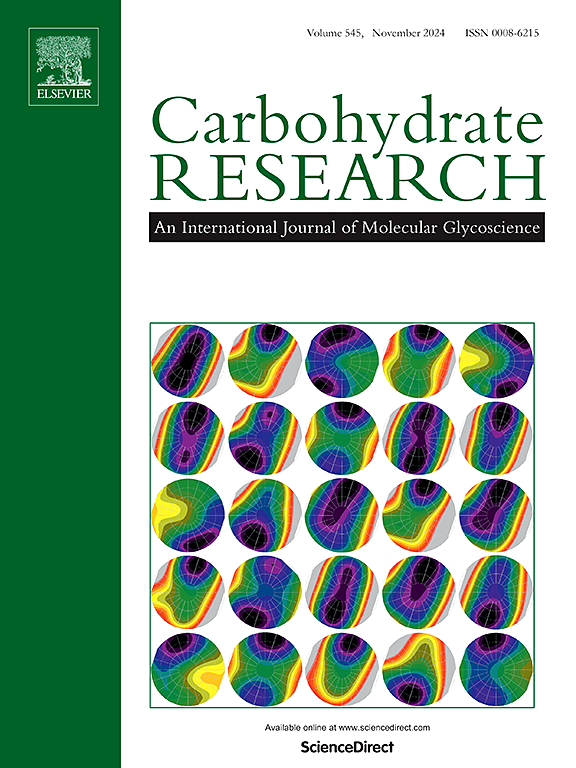新型苯并恶嗪交联磁性壳聚糖对罗丹明B染料的有效去除
IF 2.5
3区 化学
Q3 BIOCHEMISTRY & MOLECULAR BIOLOGY
引用次数: 0
摘要
水污染和染料污染对环境造成了严重的挑战,需要开发高效、可持续的吸附材料。在这项研究中,我们报道了一种新型的磁性壳聚糖基纳米复合材料,通过2-羟基-1,4-苯并恶嗪、戊二醛交联和Fe3O4的掺入合成了Ch-BOX/Glu/Fe3O4,用于去除罗丹明B染料。FTIR、HNMR、XRD、SEM、TEM、TGA、EDX等综合表征证实改性成功,Fe3O4粒径达到10.4 nm,热稳定性T50 = 420℃。在吸附剂用量为0.5 g、初始染料浓度为20 mg/L、温度为25℃、时间为3 d的条件下,Ch-BOX/Glu和Ch-BOX/Glu/Fe3O4的最大去除率分别为81.3%和79.7%。动力学分析表明,吸附符合拟二阶模型,R2 = 0.99,证实了化学吸附。可重用性测试表明,Ch-BOX/Glu/Fe3O4在3次循环后仍保持60%的去除率,而Ch-BOX/Glu/Fe3O4的去除率为35%,表明非磁性复合材料具有较高的长期稳定性。这项工作介绍了一种创新的壳聚糖-苯并恶嗪-磁铁矿混合平台,该平台结合了结构稳定性,高效脱除染料和可回收性,突出了其未来废水处理应用的潜力。本文章由计算机程序翻译,如有差异,请以英文原文为准。

Effective removal of Rhodamine B dye using novel benzoxazine-crosslinked magnetic chitosan
Water pollution and dye contamination pose serious environmental challenges, necessitating the development of efficient and sustainable adsorbent materials. In this study, we report a novel magnetic Chitosan-based nanocomposite synthesized by functionalization with 2-hydroxy-1,4-benzoxazine, glutaraldehyde crosslinking, and Fe3O4 incorporation Ch-BOX/Glu/Fe3O4 for the removal of Rhodamine B dye. Comprehensive characterization FTIR, HNMR, XRD, SEM, TEM, TGA, EDX confirmed the successful modification, with Fe3O4 particle size of 10.4 nm and enhanced thermal stability T50 = 420 °C. Under optimized conditions 0.5 g adsorbent dose, 20 mg/L initial dye concentration, 25 °C, 3 days, the maximum dye removal efficiency reached 81.3 % for Ch-BOX/Glu and 79.7 % for Ch-BOX/Glu/Fe3O4. Kinetic analysis revealed that the adsorption followed a pseudo-second-order model R2 = 0.99, confirming chemisorption. Reusability tests demonstrated that Ch-BOX/Glu retained 60 % removal efficiency after 3 cycles, while Ch-BOX/Glu/Fe3O4 retained 35 %, indicating comparatively higher long-term stability for the non-magnetic composite. This work introduces an innovative Chitosan-benzoxazine-magnetite hybrid platform that combines structural stability, efficient dye removal, and recyclability, highlighting its potential for future wastewater treatment applications.
求助全文
通过发布文献求助,成功后即可免费获取论文全文。
去求助
来源期刊

Carbohydrate Research
化学-生化与分子生物学
CiteScore
5.00
自引率
3.20%
发文量
183
审稿时长
3.6 weeks
期刊介绍:
Carbohydrate Research publishes reports of original research in the following areas of carbohydrate science: action of enzymes, analytical chemistry, biochemistry (biosynthesis, degradation, structural and functional biochemistry, conformation, molecular recognition, enzyme mechanisms, carbohydrate-processing enzymes, including glycosidases and glycosyltransferases), chemical synthesis, isolation of natural products, physicochemical studies, reactions and their mechanisms, the study of structures and stereochemistry, and technological aspects.
Papers on polysaccharides should have a "molecular" component; that is a paper on new or modified polysaccharides should include structural information and characterization in addition to the usual studies of rheological properties and the like. A paper on a new, naturally occurring polysaccharide should include structural information, defining monosaccharide components and linkage sequence.
Papers devoted wholly or partly to X-ray crystallographic studies, or to computational aspects (molecular mechanics or molecular orbital calculations, simulations via molecular dynamics), will be considered if they meet certain criteria. For computational papers the requirements are that the methods used be specified in sufficient detail to permit replication of the results, and that the conclusions be shown to have relevance to experimental observations - the authors'' own data or data from the literature. Specific directions for the presentation of X-ray data are given below under Results and "discussion".
 求助内容:
求助内容: 应助结果提醒方式:
应助结果提醒方式:


